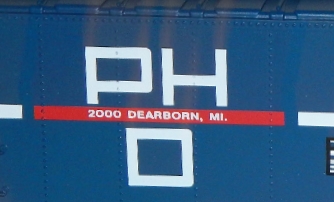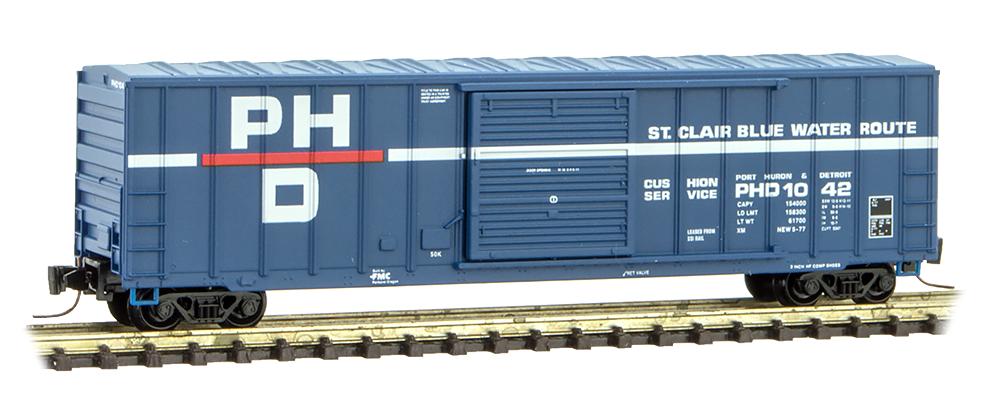Specific Item Information: This 50’ rib side box car with single door and no roofwalk is blue with white band and herald and runs on Barber Roller Bearing trucks. The Port Huron & Detroit Railroad was incorporated on September 1, 1917 and remained in business until 1984 when it was sold to the Chesapeake & Ohio Railroad. To encourage the return of the boxcars, short line railroads like Port Huron, could charge a per diem, or daily fee, until the cars were returned.
Series Name: Per Diem
Prototype History: While the 40-foot boxcar was a standard design, and it did come in different setups depending on the type of freight being transported, it was not large enough for efficient mass commodity transportation. The 50-foot boxcar made its first appearance in the 1930s and steadily grew in popularity over the years, which further improved redundancies by allowing for even more space within a given car. Today, the 50-footer remains the common boxcar size. After the second world war ended, and steel became once again readily available, steel became the go-to choice for construction of boxcars. Pullman Standard and ACF were some of the most prolific builders of these cars.
These cars came in many variations. For instance, double-doors became practical for large/wide loads, end-doors useful for very large lading such as automobiles, and interior tie-down equipment was helpful in keeping sensitive products from being damaged in-transit. In 1954 the Santa Fe developed its "Shock Control" (and later "Super Shock Control") technology for new boxcars with upgraded suspension systems to further improve the ride-quality and reduce the chance of damaging freight.
In the 1960s, the flush, "plug" style sliding door was introduced as an option that provides a larger door to ease loading and unloading of certain commodities. The tight-fitting doors are better insulated and allow a car's interior to be maintained at a more even temperature.
These cars came in many variations. For instance, double-doors became practical for large/wide loads, end-doors useful for very large lading such as automobiles, and interior tie-down equipment was helpful in keeping sensitive products from being damaged in-transit. In 1954 the Santa Fe developed its "Shock Control" (and later "Super Shock Control") technology for new boxcars with upgraded suspension systems to further improve the ride-quality and reduce the chance of damaging freight.
In the 1960s, the flush, "plug" style sliding door was introduced as an option that provides a larger door to ease loading and unloading of certain commodities. The tight-fitting doors are better insulated and allow a car's interior to be maintained at a more even temperature.
Road Name History:  The PH&D was established in 1917 to purchase and extend the Port Huron & Southern Railroad. While there were grand plans to build to Detroit, the PH&D only got from Port Huron to Marine City, Michigan, 14 miles away. Nevertheless, the PH&D kept busy hauling auto parts, coal, salt, steel, chemicals, rubber and sugar beets. In the steam era, PH&D hosted a fleet of 0-6-0 switchers. These were gradually replaced with a trio of Alco diesel switchers. The Duffy Family who had owned the railroad since 1922, sold it to Chesapeake & Ohio in 1984. C&O successor CSX officially merged it into their system in 1989. CSX continues to operate the route.
The PH&D was established in 1917 to purchase and extend the Port Huron & Southern Railroad. While there were grand plans to build to Detroit, the PH&D only got from Port Huron to Marine City, Michigan, 14 miles away. Nevertheless, the PH&D kept busy hauling auto parts, coal, salt, steel, chemicals, rubber and sugar beets. In the steam era, PH&D hosted a fleet of 0-6-0 switchers. These were gradually replaced with a trio of Alco diesel switchers. The Duffy Family who had owned the railroad since 1922, sold it to Chesapeake & Ohio in 1984. C&O successor CSX officially merged it into their system in 1989. CSX continues to operate the route.

Brand/Importer Information: Micro-Trains Line split off from Kadee Quality Products in 1990. Kadee Quality Products originally got involved in N-Scale by producing a scaled-down version of their successful HO Magne-Matic knuckle coupler system. This coupler was superior to the ubiquitous 'Rapido' style coupler due to two primary factors: superior realistic appearance and the ability to automatically uncouple when stopped over a magnet embedded in a section of track. The success of these couplers in N-Scale quickly translated to the production of trucks, wheels and in 1972 a release of ready-to-run box cars.
Micro-Trains Line Co. split off from Kadee in 1990 to form a completely independent company. For this reason, products from this company can appear with labels from both enterprises. Due to the nature of production idiosyncrasies and various random factors, the rolling stock from Micro-Trains can have all sorts of interesting variations in both their packaging as well as the products themselves. When acquiring an MTL product it is very important to understand these important production variations that can greatly enhance (or decrease) the value of your purchase.
Micro-Trains Line Co. split off from Kadee in 1990 to form a completely independent company. For this reason, products from this company can appear with labels from both enterprises. Due to the nature of production idiosyncrasies and various random factors, the rolling stock from Micro-Trains can have all sorts of interesting variations in both their packaging as well as the products themselves. When acquiring an MTL product it is very important to understand these important production variations that can greatly enhance (or decrease) the value of your purchase.
Item created by: gdm on 2019-02-27 12:50:58. Last edited by gdm on 2019-05-08 13:58:37
If you see errors or missing data in this entry, please feel free to log in and edit it. Anyone with a Gmail account can log in instantly.
If you see errors or missing data in this entry, please feel free to log in and edit it. Anyone with a Gmail account can log in instantly.









